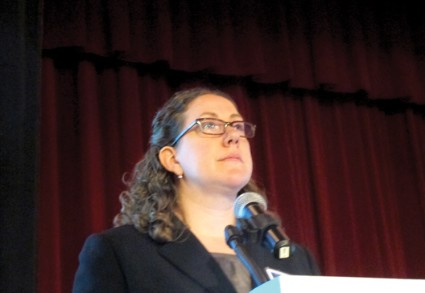User login
BOSTON – Relaxing eligibility criteria for cytoreductive surgery may improve overall survival among patients with carcinoid metastases to the liver, investigators report.
Lowering the debulking threshold from 90% to 70% and including patients with intermediate-grade disease and/or extrahepatic disease resulted in 5-year overall survival rates of 90%, compared with 61%-74% rates reported by other treatment centers, said Dr. Amanda N. Graff-Baker, a surgical oncology resident at the Oregon Health and Science University (OHSU), Portland.
"The use of expanded criteria would substantially increase the number of patients eligible for debulking without compromising survival," she reported at the annual meeting of the American Association of Endocrine Surgeons.
Carcinoid tumors, a subset of neuroendocrine tumors, originate in the enterochromaffin cells of the aerodigestive tract. Approximately 60% of these tumors occur in the gastrointestinal tract, most commonly in the small intestine.
Approximately 60%-80% of patients with small bowel carcinoid tumors will have metastases to the liver, with liver failure from hepatic replacement by tumor being the most common cause of death, she explained.
Although there are no standardized patient selection criteria for liver debulking surgery in these patients, many U.S. centers follow NANETS (North American Neuroendocrine Tumor Society) treatment guidelines, which recommend surgical excision of at least 90% of all visible tumor. In addition, many centers choose not to offer cytoreductive surgery to patients with extrahepatic disease, Dr. Graff-Baker said.
Using these criteria, centers have reported 5-year survival rates ranging from 61% to 74%, but only about 20% of patients with carcinoid metastases to the liver are eligible for resection.
The investigators hypothesized that expanded eligibility criteria used at OHSU for several years could improve both liver progression-free and disease-specific survival rates. The criteria include a lower liver debulking threshold (70% or greater) and allow inclusion of patients with extrahepatic disease and/or intermediate-grade tumors.
They tested this idea by reviewing records of patients with metastatic carcinoid tumors who underwent liver debulking procedures at their center from 2007 to 2011. A single pathologist rated the grade of primary and metastatic tumors, and investigators correlated clinical factors with outcomes.
They identified a total of 52 patients, ranging in age from 29 to 77 years. Of this group, 32 (62%) had carcinoid syndrome, and 34 (65%) had extrahepatic disease.
The patients underwent a total of 51 wedge resections and 16 anatomic resections.
The mean number of metastases resected was 22 (range, 1-131). The mean size of metastases was 3 cm (range, 0.3-16 cm).
On pathologic review, all primary tumors were found to be low grade, but one-third of patients had one or more intermediate-grade metastases, suggesting a significant degree of tumor heterogeneity, Dr. Graff-Baker said.
The median liver progression-free survival was 72 months. A comparison between patients with liver progression and those with stable liver disease showed that there were no significant differences between the groups in either the percentage of tumor resected, number of resections, tumor size, presence of one or more intermediate-grade metastases, or extrahepatic disease. The only factor associated with a significant difference between groups was age. The mean age of patients with stable disease was 60.1 years, compared with 52 years for patients with liver progression (P = .016).
A separate analysis by age confirmed the last finding, with patients 50 years and older having significantly better liver progression-free survival than patients under age 50 (P = .001).
The 5-year disease-specific survival rate among all patients was 90%. All deaths were due to liver failure caused by tumor progression.
An analysis of factors predicting disease-specific survival showed once again that older patients for a change fared better than their more youthful counterparts (P = .03).
"The number, size, grade, extent of resection, and presence of extrahepatic disease did not have an adverse impact on outcomes," Dr. Graff-Baker said.
The study was internally funded. Dr. Graff-Baker reported having no financial disclosures.
BOSTON – Relaxing eligibility criteria for cytoreductive surgery may improve overall survival among patients with carcinoid metastases to the liver, investigators report.
Lowering the debulking threshold from 90% to 70% and including patients with intermediate-grade disease and/or extrahepatic disease resulted in 5-year overall survival rates of 90%, compared with 61%-74% rates reported by other treatment centers, said Dr. Amanda N. Graff-Baker, a surgical oncology resident at the Oregon Health and Science University (OHSU), Portland.
"The use of expanded criteria would substantially increase the number of patients eligible for debulking without compromising survival," she reported at the annual meeting of the American Association of Endocrine Surgeons.
Carcinoid tumors, a subset of neuroendocrine tumors, originate in the enterochromaffin cells of the aerodigestive tract. Approximately 60% of these tumors occur in the gastrointestinal tract, most commonly in the small intestine.
Approximately 60%-80% of patients with small bowel carcinoid tumors will have metastases to the liver, with liver failure from hepatic replacement by tumor being the most common cause of death, she explained.
Although there are no standardized patient selection criteria for liver debulking surgery in these patients, many U.S. centers follow NANETS (North American Neuroendocrine Tumor Society) treatment guidelines, which recommend surgical excision of at least 90% of all visible tumor. In addition, many centers choose not to offer cytoreductive surgery to patients with extrahepatic disease, Dr. Graff-Baker said.
Using these criteria, centers have reported 5-year survival rates ranging from 61% to 74%, but only about 20% of patients with carcinoid metastases to the liver are eligible for resection.
The investigators hypothesized that expanded eligibility criteria used at OHSU for several years could improve both liver progression-free and disease-specific survival rates. The criteria include a lower liver debulking threshold (70% or greater) and allow inclusion of patients with extrahepatic disease and/or intermediate-grade tumors.
They tested this idea by reviewing records of patients with metastatic carcinoid tumors who underwent liver debulking procedures at their center from 2007 to 2011. A single pathologist rated the grade of primary and metastatic tumors, and investigators correlated clinical factors with outcomes.
They identified a total of 52 patients, ranging in age from 29 to 77 years. Of this group, 32 (62%) had carcinoid syndrome, and 34 (65%) had extrahepatic disease.
The patients underwent a total of 51 wedge resections and 16 anatomic resections.
The mean number of metastases resected was 22 (range, 1-131). The mean size of metastases was 3 cm (range, 0.3-16 cm).
On pathologic review, all primary tumors were found to be low grade, but one-third of patients had one or more intermediate-grade metastases, suggesting a significant degree of tumor heterogeneity, Dr. Graff-Baker said.
The median liver progression-free survival was 72 months. A comparison between patients with liver progression and those with stable liver disease showed that there were no significant differences between the groups in either the percentage of tumor resected, number of resections, tumor size, presence of one or more intermediate-grade metastases, or extrahepatic disease. The only factor associated with a significant difference between groups was age. The mean age of patients with stable disease was 60.1 years, compared with 52 years for patients with liver progression (P = .016).
A separate analysis by age confirmed the last finding, with patients 50 years and older having significantly better liver progression-free survival than patients under age 50 (P = .001).
The 5-year disease-specific survival rate among all patients was 90%. All deaths were due to liver failure caused by tumor progression.
An analysis of factors predicting disease-specific survival showed once again that older patients for a change fared better than their more youthful counterparts (P = .03).
"The number, size, grade, extent of resection, and presence of extrahepatic disease did not have an adverse impact on outcomes," Dr. Graff-Baker said.
The study was internally funded. Dr. Graff-Baker reported having no financial disclosures.
BOSTON – Relaxing eligibility criteria for cytoreductive surgery may improve overall survival among patients with carcinoid metastases to the liver, investigators report.
Lowering the debulking threshold from 90% to 70% and including patients with intermediate-grade disease and/or extrahepatic disease resulted in 5-year overall survival rates of 90%, compared with 61%-74% rates reported by other treatment centers, said Dr. Amanda N. Graff-Baker, a surgical oncology resident at the Oregon Health and Science University (OHSU), Portland.
"The use of expanded criteria would substantially increase the number of patients eligible for debulking without compromising survival," she reported at the annual meeting of the American Association of Endocrine Surgeons.
Carcinoid tumors, a subset of neuroendocrine tumors, originate in the enterochromaffin cells of the aerodigestive tract. Approximately 60% of these tumors occur in the gastrointestinal tract, most commonly in the small intestine.
Approximately 60%-80% of patients with small bowel carcinoid tumors will have metastases to the liver, with liver failure from hepatic replacement by tumor being the most common cause of death, she explained.
Although there are no standardized patient selection criteria for liver debulking surgery in these patients, many U.S. centers follow NANETS (North American Neuroendocrine Tumor Society) treatment guidelines, which recommend surgical excision of at least 90% of all visible tumor. In addition, many centers choose not to offer cytoreductive surgery to patients with extrahepatic disease, Dr. Graff-Baker said.
Using these criteria, centers have reported 5-year survival rates ranging from 61% to 74%, but only about 20% of patients with carcinoid metastases to the liver are eligible for resection.
The investigators hypothesized that expanded eligibility criteria used at OHSU for several years could improve both liver progression-free and disease-specific survival rates. The criteria include a lower liver debulking threshold (70% or greater) and allow inclusion of patients with extrahepatic disease and/or intermediate-grade tumors.
They tested this idea by reviewing records of patients with metastatic carcinoid tumors who underwent liver debulking procedures at their center from 2007 to 2011. A single pathologist rated the grade of primary and metastatic tumors, and investigators correlated clinical factors with outcomes.
They identified a total of 52 patients, ranging in age from 29 to 77 years. Of this group, 32 (62%) had carcinoid syndrome, and 34 (65%) had extrahepatic disease.
The patients underwent a total of 51 wedge resections and 16 anatomic resections.
The mean number of metastases resected was 22 (range, 1-131). The mean size of metastases was 3 cm (range, 0.3-16 cm).
On pathologic review, all primary tumors were found to be low grade, but one-third of patients had one or more intermediate-grade metastases, suggesting a significant degree of tumor heterogeneity, Dr. Graff-Baker said.
The median liver progression-free survival was 72 months. A comparison between patients with liver progression and those with stable liver disease showed that there were no significant differences between the groups in either the percentage of tumor resected, number of resections, tumor size, presence of one or more intermediate-grade metastases, or extrahepatic disease. The only factor associated with a significant difference between groups was age. The mean age of patients with stable disease was 60.1 years, compared with 52 years for patients with liver progression (P = .016).
A separate analysis by age confirmed the last finding, with patients 50 years and older having significantly better liver progression-free survival than patients under age 50 (P = .001).
The 5-year disease-specific survival rate among all patients was 90%. All deaths were due to liver failure caused by tumor progression.
An analysis of factors predicting disease-specific survival showed once again that older patients for a change fared better than their more youthful counterparts (P = .03).
"The number, size, grade, extent of resection, and presence of extrahepatic disease did not have an adverse impact on outcomes," Dr. Graff-Baker said.
The study was internally funded. Dr. Graff-Baker reported having no financial disclosures.
AT AAES 2014
Major finding: The 5-year survival rate of patients with carcinoid liver metastases treated under expanded debulking criteria was 90%, compared with 61%-74% reported by other centers.
Data source: Single-institution review of data on 52 patients.
Disclosures: The study was internally funded. Dr. Graff-Baker reported having no financial disclosures.

